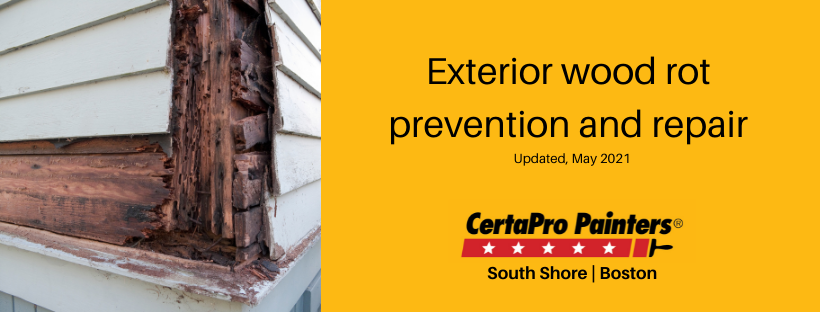
Wood Rot Repair in Boston & South Shore Areas
Posted on October 1, 2019
The Boston and South Shore areas are notorious for their Colonials and Cape-style homes with exteriors made of wood. Most South Shore clapboards and trim are made of wood, and some South Shore homes even have cedar roofs and wooden gutters!
Many commercial buildings try to emulate the aesthetic by adding wood touches to their exteriors in the form or pillars, shutters, shingles and clapboards.
While wood exteriors offer a classic look, our cold and wet winters combined with the salt air cause wood rot to be an issue in our area.
Signs of Rotting Wood on your South Shore home:
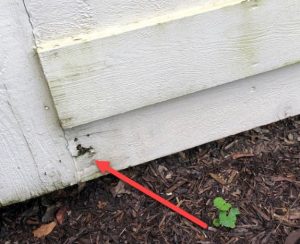
Wood rots first in areas of high moisture: trim, sills, and areas close to the ground are target areas. Of course, if a tiny bit of rot is ignored, it becomes a bigger problem.
Fixing wood rot as soon as it appears is a classic case of “a stitch in time saves nine.”
We have carpenters on staff to replace the rotted wood before painting. About 60% of the homes and commercial buildings we paint need some wood replaced beforehand – something we’re used to handling. And once you hire us, we take care of the carpentry, so you don’t have to hire a separate carpenter before we paint.
Leaving wood rotting and untreated could compromise the structural integrity of homes and lead to extensive and costly repairs.
Some signs that your exterior wood is rotting:
- Peeling paint
- Spongy wood – if you can put a screwdriver through a shingle, it is rotted.
- The presence of mold, mildew, or fungi
Trim board options for your home’s exterior
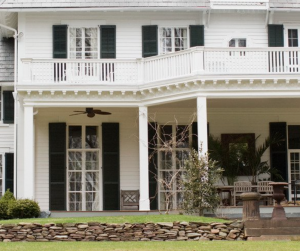
Many South Shore/Plymouth area customers replace their trim with PVC trim (such as Azek). While PVC trim is more expensive than wood trim, it does not rot or decay and does not expand and contract as much as wood.
The good news is that while PVC material is more expensive than wood, the labor to install it is about the same.
Most of the time, some of your wood trim will not be rotted and won’t rot for years. Wood trim is most vulnerable to rotting in areas of high moisture (like the trim touching the ground).
In most cases, we can replace only the rotted trim boards with PVC and leave wood that’s not rotted in place. This saves our clients money and is a perfectly sound solution.
Since PVC is 100% paintable and looks just like wood trim, when we splice in a few PVC trim boards to your otherwise wood-trimmed home, the PVC blends right in once it’s painted, and you can’t tell the difference between the wood and PVC trim on the home.
We can even use PVC trim boards in historical profiles, combining PVC’s durability with keeping your home looking historically authentic.
What about the cost of replacing trim with PVC vs. Trim?
The PVC boards will be slightly more expensive in the short term, but since the labor is the same as installing wood, you’ll save money and hassle in the long run by never having to replace those trim boards again.
Preventing exterior wood rot on your home.
Especially in New England, the exterior wood on your home needs serious protection from wood rot. Houses may experience structural damage if wood rot is left unchecked. Fortunately, there are a few ways to prevent wood rot – let’s dig in:
Causes of wood rot on your exterior:
Wood rot is a form of decay triggered by moisture. For example, in the Boston area, water may puddle on your deck floorboards and take a day to dry after a rainstorm. Or your exterior trim that touches your driveway might soak up moisture and take a while to dry out. When this happens, microscopic organisms that can get inside the wood can cause it to rot. This, in turn, weakens the fibers of the wood and compromises its integrity.
If your home’s exterior already has wood rot, you must replace the wood in those spots.
Don’t paint over rotted wood:
It cannot be stressed enough—if the wood on your home’s exterior is rotted, you cannot paint over it to “fix” the rot. If you paint over wood rot, the paint will peel, and more moisture will seep into the wood.
“What parts of my exterior are most vulnerable to wood rot?”
Most of the time, moisture gets into cracks in the wood and underneath cracked or peeling paint. The photo below gives you a sense of the many vulnerable areas on your home’s exterior for wood rot.
Seams, cuts, corners, and areas closest to the ground tend to hold moisture and are more susceptible to wood rot.
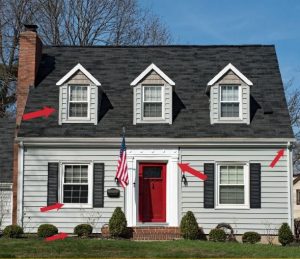
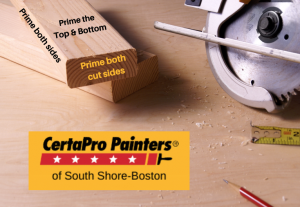
“How many sides of the wood should I paint when installing new wood?”
Prime all six sides of the board, even the cuts. The primer will help keep moisture out and prolong the wood’s longevity.
Staining the underside of a new wood deck is not a common practice, but it will help protect the wood.
Is pressure-treated wood less prone to wood rot?
Yes. Pressure-treated wood undergoes a chemical process in a pressure chamber to make it more durable and less prone to decay.
As a result, decks, fences, floating docks, and other structures are great uses of pressure-treated wood in New England.
Should I install a wooden deck or use synthetic wood like Trex?
As much as we’d like to paint your deck year after year, we definitely recommend synthetic woods like Trex because:
While more expensive to install, Trex decks need no ongoing staining.
Wood decks—especially Mahogany decks—must be stained yearly to keep them looking great and protected. The minute you stain them, the clock starts ticking, and foot traffic, hot sun, and water puddling fade the stain, so the next summer, it needs to be restained. Staining a deck is usually $1,000+ and requires time that we just don’t think you need to spend. Go with Trex.
Our carpenters can install Trex decking for you. Click here to schedule a quote.
Applying caulk to prevent wood rot
To prevent wood rot, seal all cracks in the wood and around exterior doors and windows with a latex exterior caulk.
If you notice dry, old, hardened caulk in the gaps or seams, dig or scrape it out as best you can before applying a bead of new caulk.
Do paint and stain prevent wood rot?
Your home’s wooden exterior is painted or stained to help protect the wood and keep the moisture out.
Stains penetrate the wood, while paints sit on the wood’s surface.
Both paint and stain protect wood from from wood rot.
Once you see the paint and stain fading, this is a clue that your home may not be protected. This happens every 5-7 years in our area and even earlier for homes directly on the coast which are exposed to wind and the salt air.
You also might like to read:
Paint vs. stain – which one is better for my Massachusetts exterior?
The care and maintenance of mahogany decks
More about our Boston-area carpentry services
Written by Paige NeJame, the owner of CertaPro Painters and a national painting expert with dozens of mentions in publications like Family Handyman, Forbes, Apartment Therapy and Martha Stewart.






